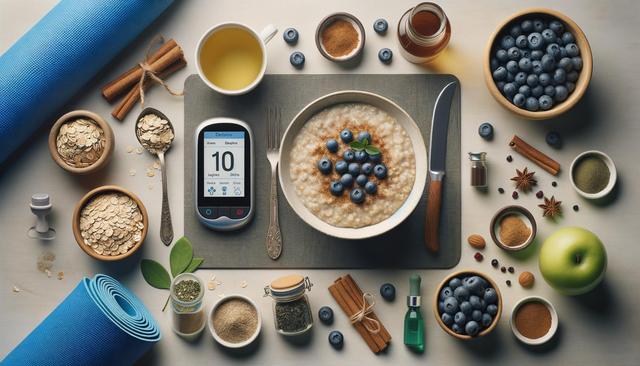Understanding Blood Sugar and Its Impact
Blood sugar, or blood glucose, is the primary source of energy for the body’s cells. When levels become too high, it can lead to serious health issues such as type 2 diabetes, nerve damage, and cardiovascular problems. Maintaining a balanced blood sugar level is crucial for overall well-being. Several factors influence blood glucose, including diet, physical activity, sleep, and stress levels. At home, small and consistent changes can help regulate blood sugar and support long-term health goals.
Understanding how the body processes carbohydrates is essential. Carbs break down into glucose, which enters the bloodstream. The hormone insulin helps transport this glucose into cells. When insulin resistance develops, this process is disrupted, leading to elevated sugar levels. Recognizing the signs—such as excessive thirst, frequent urination, fatigue, and blurred vision—can prompt early action. With basic knowledge and the right techniques, it’s possible to manage blood sugar without relying solely on medication.
Smart Food Choices and Home Recipes
Diet plays a central role in blood sugar management. Simple adjustments in your meals can lead to noticeable improvements. Focus on whole foods with a low glycemic index (GI), which release glucose slowly into the bloodstream. Here are some practical tips and meal ideas:
- Include more fiber-rich foods like lentils, beans, and leafy greens.
- Opt for whole grains such as quinoa, oats, and brown rice.
- Use healthy fats like olive oil, nuts, and avocados.
- Limit refined sugar and processed snacks.
Try this simple home recipe: A vegetable stir-fry made with broccoli, garlic, bell peppers, and tofu, cooked in olive oil and flavored with turmeric. Turmeric contains curcumin, which may support insulin sensitivity. Another easy option is a chia seed pudding made with unsweetened almond milk and cinnamon, a spice known for its potential to regulate glucose levels.
Herbal and Natural Remedies
Various herbs and natural ingredients have been traditionally used to support blood sugar regulation. While they’re not substitutes for medical treatment, they can be complementary tools. Some commonly used options include:
- Fenugreek seeds: These can be soaked overnight and consumed in the morning.
- Bitter melon: Often included in juices or stir-fries, it’s thought to mimic insulin activity.
- Cinnamon: A versatile spice that may help improve insulin sensitivity.
- Aloe vera juice: Used in moderation, it may help lower fasting glucose.
Before incorporating these remedies, it’s advisable to consult a healthcare provider, especially if you’re already on medication. Also, moderation is key to avoiding unwanted side effects. These ingredients can be easily added to home-cooked dishes or teas, offering a convenient way to support blood sugar balance naturally.
Physical Activity and Lifestyle Habits
Regular movement is an effective strategy for lowering blood sugar levels. Exercise helps muscles use glucose for energy, thereby reducing its concentration in the blood. You don’t need a gym membership—simple activities at home can be highly effective. Options include:
- Brisk walking for 30 minutes daily
- Bodyweight exercises like squats, push-ups, and lunges
- Yoga or stretching routines to reduce stress and improve flexibility
Besides physical activity, other lifestyle habits matter. Quality sleep helps regulate insulin and cortisol, both of which influence blood sugar. Aim for 7–8 hours of restful sleep per night. Managing stress through mindfulness, breathing exercises, or hobbies can also prevent spikes in glucose caused by elevated cortisol levels. Consistency in daily routines, including meal times and bedtime, plays a supportive role in maintaining stable blood sugar.
Monitoring and Personal Awareness
Keeping track of your blood sugar can provide valuable insights into what works and what doesn’t. Home glucose monitors are widely available and easy to use. Regular monitoring helps identify patterns and triggers, such as which meals cause spikes or how your body responds to physical activity. Some key practices include:
- Checking blood sugar at the same times daily
- Keeping a food and activity journal
- Noting stress levels and sleep quality
Awareness also involves understanding your body’s signals. Feeling overly tired after meals, experiencing mood swings, or noticing changes in vision could be signs of fluctuating glucose levels. By becoming more attuned to these indicators, you can make proactive adjustments. Empowering yourself with knowledge and attention to detail can significantly improve your ability to manage blood sugar effectively at home.
Conclusion: Taking Control with Everyday Steps
Managing blood sugar doesn’t require drastic measures. With informed food choices, natural home remedies, regular movement, and mindful habits, it’s possible to maintain healthy glucose levels in a sustainable way. These strategies are especially helpful for those looking to support their wellness from the comfort of home. By staying consistent and paying attention to your body’s responses, you can take meaningful steps toward better health and long-term balance.




Leave a Reply